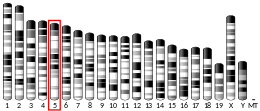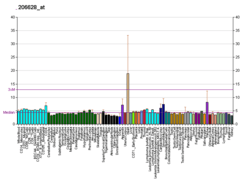Sodium/glucose cotransporter 1
Sodium/glucose cotransporter 1 (SGLT1) also known as solute carrier family 5 member 1 is a protein in humans that is encoded by the SLC5A1 gene[5][6] which encodes the production of the SGLT1 protein to line the absorptive cells in the small intestine and the epithelial cells of the kidney tubules of the nephron for the purpose of glucose uptake into cells.[7] Through the use of the sodium glucose cotransporter 1 protein, cells are able to obtain glucose which is further utilized to make and store energy for the cell.
Structure
The sodium glucose cotransporter 1 is classified as an integral protein that is made up of 14 alpha-helices constructed from the folding of 482-718 amino acid residues with both the N and C-terminal residing upon the extracellular side of the plasma membrane.[8] It is hypothesized that the protein contains protein kinase A and protein kinase C phosphorylation sites, which serve to regulate the proteins conformational shape through phosphorylation of amino acids with ATP.[8][9]
Function
Glucose transporters are integral membrane proteins that mediate the transport of glucose and structurally related substances across cellular membranes. Two families of glucose transporter have been identified: the facilitated diffusion glucose transporter family (GLUT family), also known as uniporters, and the sodium-dependent glucose transporter family (SGLT family), also known as cotransporters or symporters.[10] The SLC5A1 gene encodes the sodium glucose cotransporter protein that is involved in the facilitated transport of glucose and galactose into eukaryotic and prokaryotic cells.[6] The role of the sodium-glucose cotransporter 1 is to absorb D-glucose and D-galactose from the brush-border membrane of the small intestines,[11][12] while also exchanging sodium ions and glucose from the tubule of the nephron.[13] The SGLT1 protein is able to uptake glucose through cellular membranes through coupling the energy generated from cotransporting 2 sodium ions with glucose through a symport mechanism.[14] This protein does not use ATP to generate energy.[14]
Transport mechanism
The sodium glucose cotransporter is original arranged with an outward-facing conformation with open receptors in preparation for 2 sodium ions and glucose to simultaneously bind.[7] Once bound, the protein receptor will change conformation to an occluded conformation, which prevents the dissociation of the sodium ions and glucose.[7] The protein will then change conformations once more to an inward-facing conformation in which allows sodium and glucose will to dissociate.[7] The protein then returns to the outward-facing conformation state, ready to bind more sodium ions and glucose.[7]
Cloning
Co-transport proteins of mammalian cell membranes had eluded efforts of purification with classical biochemical methods until the late 1980s. These proteins had proven difficult to isolate because they contain hydrophilic and hydrophobic sequences and exist in membranes only in very low abundance (<0.2% of membrane proteins). The rabbit form of SGLT1 was the first mammalian co-transport protein ever to be cloned and sequenced, and this was reported in 1987.[15] To circumvent the difficulties with traditional isolation methods, a novel expression cloning technique was used. Size-fractionation of large amounts of rabbit intestinal mRNA with preparative gel electrophoresis were then sequentially injected into Xenopus oocytes to ultimately find the RNA species that induced the expression of sodium-glucose cotransport.[15]
Mutations
SLC5A1 is medically relevant because of its role in the absorption of glucose and sodium, however, mutations in the gene can cause medical implications. A missense mutation[16] in the SLC5A1 gene of exon 1 can cause problems creating the SGLT1 protein, leading to a rare glucose-galactose malabsorption disease.[16] This is because the mutation destroys the transport function.[16] Glucose-galactose malabsorption occurs when the lining of the intestinal cells cannot take in glucose and galactose which prevents the use of those molecules in catabolism and anabolism. The disease has symptoms that consist of watery and/or acidic diarrhea which is the result of water retention in the intestinal lumen and osmotic loss created by non-absorbed glucose, galactose and sodium.[17] Glucose-Galactose malabsorption can cause death due to loss of water from diarrhea if the disease is not treated.[16] To counteract the disease and the effects of acute diarrhea and dehydration, the sodium glucose cotransporter 1 protein is targeted for its mechanistic benefits with ion transfers by oral rehydration therapy through increasing sodium, glucose, and water concentrations for intestinal reabsorption.[16]
Tissue distribution
The SLC5A1 cotransporter is mainly expressed in the lumen of the small intestine, kidney, parotid glands, submandibular glands and in the heart.[18]
See also
- Solute carrier family
- SGLT Family
- SGLT2
References
- GRCh38: Ensembl release 89: ENSG00000100170 - Ensembl, May 2017
- GRCm38: Ensembl release 89: ENSMUSG00000011034 - Ensembl, May 2017
- "Human PubMed Reference:". National Center for Biotechnology Information, U.S. National Library of Medicine.
- "Mouse PubMed Reference:". National Center for Biotechnology Information, U.S. National Library of Medicine.
- Turk E, Martín MG, Wright EM (May 1994). "Structure of the human Na+/glucose cotransporter gene SGLT1". The Journal of Biological Chemistry. 269 (21): 15204–9. PMID 8195156.
- "Entrez Gene: SLC5A1 solute carrier family 5 (sodium/glucose cotransporter), member 1".
- Lodish H, Berk A, Kaiser CA, Krieger M, Bretscher A, Ploegh H, Amon A, Martin KC (April 2016). Molecular cell biology (Eighth ed.). New York. ISBN 9781464183393. OCLC 949909675.
- Wright EM, Hirsch JR, Loo DD, Zampighi GA (January 1997). "Regulation of Na+/glucose cotransporters". The Journal of Experimental Biology. 200 (Pt 2): 287–93. PMID 9050236.
- Avendaño C, Menéndez JC (2008). "Drugs That Inhibit Signalling Pathways for Tumor Cell Growth and Proliferation". Medicinal Chemistry of Anticancer Drugs. Elsevier. pp. 251–305. doi:10.1016/b978-0-444-52824-7.00009-3. ISBN 9780444528247.
- Wright EM, Loo DD, Panayotova-Heiermann M, Lostao MP, Hirayama BH, Mackenzie B, et al. (November 1994). "'Active' sugar transport in eukaryotes" (PDF). The Journal of Experimental Biology. 196: 197–212. PMID 7823022.
- Wright EM, Turk E (February 2004). "The sodium/glucose cotransport family SLC5". Pflügers Archiv. 447 (5): 510–8. doi:10.1007/s00424-003-1063-6. PMID 12748858.
- Gorboulev, V.; Schurmann, A.; Vallon, V.; Kipp, H.; Jaschke, A.; Klessen, D.; Friedrich, A.; Scherneck, S.; Rieg, T.; Cunard, R.; Veyhl-Wichmann, M. (2012-01-01). "Na+-D-glucose Cotransporter SGLT1 is Pivotal for Intestinal Glucose Absorption and Glucose-Dependent Incretin Secretion". Diabetes. 61 (1): 187–196. doi:10.2337/db11-1029. ISSN 0012-1797. PMC 3237647. PMID 22124465.
- Hamilton KL, Butt AG (December 2013). "Glucose transport into everted sacs of the small intestine of mice". Advances in Physiology Education. 37 (4): 415–26. doi:10.1152/advan.00017.2013. PMID 24292921.
- Poulsen, Søren Brandt; Fenton, Robert A.; Rieg, Timo (March 2017). "Sodium-glucose cotransport". Current Opinion in Nephrology and Hypertension. 24 (5): 463–469. doi:10.1097/MNH.0000000000000152. ISSN 1473-6543. PMC 5364028. PMID 26125647.
- Hediger MA, Coady MJ, Ikeda TS, Wright EM (1987). "Expression cloning and cDNA sequencing of the Na+/glucose co-transporter". Nature. 330 (6146): 379–81. doi:10.1038/330379a0. PMID 2446136.
- Turk E, Martín MG, Wright EM (May 1994). "Structure of the human Na+/glucose cotransporter gene SGLT1". The Journal of Biological Chemistry. 269 (21): 15204–9. PMID 8195156.
- Wright EM, Turk E, Martin MG (2002). "Molecular basis for glucose-galactose malabsorption". Cell Biochemistry and Biophysics. 36 (2–3): 115–21. doi:10.1385/CBB:36:2-3:115. PMID 12139397.
- Sabino-Silva R, Mori RC, David-Silva A, Okamoto MM, Freitas HS, Machado UF (November 2010). "The Na(+)/glucose cotransporters: from genes to therapy". Brazilian Journal of Medical and Biological Research = Revista Brasileira de Pesquisas Medicas e Biologicas. 43 (11): 1019–26. doi:10.1590/S0100-879X2010007500115. PMID 21049241.
- Xie J, Guo Q (July 2004). "Par-4 inhibits choline uptake by interacting with CHT1 and reducing its incorporation on the plasma membrane". The Journal of Biological Chemistry. 279 (27): 28266–75. doi:10.1074/jbc.M401495200. PMID 15090548.
Further reading
- Anderson NL, Anderson NG (November 2002). "The human plasma proteome: history, character, and diagnostic prospects" (PDF). Molecular & Cellular Proteomics. 1 (11): 845–67. doi:10.1074/mcp.R200007-MCP200. PMID 12488461.
- Turk E, Zabel B, Mundlos S, Dyer J, Wright EM (March 1991). "Glucose/galactose malabsorption caused by a defect in the Na+/glucose cotransporter". Nature. 350 (6316): 354–6. doi:10.1038/350354a0. PMID 2008213.
- Hediger MA, Turk E, Wright EM (August 1989). "Homology of the human intestinal Na+/glucose and Escherichia coli Na+/proline cotransporters". Proceedings of the National Academy of Sciences of the United States of America. 86 (15): 5748–52. doi:10.1073/pnas.86.15.5748. PMC 297707. PMID 2490366.
- Delézay O, Baghdiguian S, Fantini J (May 1995). "The development of Na(+)-dependent glucose transport during differentiation of an intestinal epithelial cell clone is regulated by protein kinase C". The Journal of Biological Chemistry. 270 (21): 12536–41. doi:10.1074/jbc.270.21.12536. PMID 7759499.
- Turk E, Klisak I, Bacallao R, Sparkes RS, Wright EM (September 1993). "Assignment of the human Na+/glucose cotransporter gene SGLT1 to chromosome 22q13.1". Genomics. 17 (3): 752–4. doi:10.1006/geno.1993.1399. PMID 8244393.
- Martín MG, Turk E, Lostao MP, Kerner C, Wright EM (February 1996). "Defects in Na+/glucose cotransporter (SGLT1) trafficking and function cause glucose-galactose malabsorption". Nature Genetics. 12 (2): 216–20. doi:10.1038/ng0296-216. PMID 8563765.
- Turk E, Kerner CJ, Lostao MP, Wright EM (January 1996). "Membrane topology of the human Na+/glucose cotransporter SGLT1". The Journal of Biological Chemistry. 271 (4): 1925–34. doi:10.1074/jbc.271.4.1925. PMID 8567640.
- Lam JT, Martín MG, Turk E, Hirayama BA, Bosshard NU, Steinmann B, Wright EM (February 1999). "Missense mutations in SGLT1 cause glucose-galactose malabsorption by trafficking defects". Biochimica et Biophysica Acta (BBA) - Molecular Basis of Disease. 1453 (2): 297–303. doi:10.1016/s0925-4439(98)00109-4. PMID 10036327.
- Dunham I, Shimizu N, Roe BA, Chissoe S, Hunt AR, Collins JE, et al. (December 1999). "The DNA sequence of human chromosome 22". Nature. 402 (6761): 489–95. doi:10.1038/990031. PMID 10591208.
- Obermeier S, Hüselweh B, Tinel H, Kinne RH, Kunz C (October 2000). "Expression of glucose transporters in lactating human mammary gland epithelial cells". European Journal of Nutrition. 39 (5): 194–200. doi:10.1007/s003940070011. PMID 11131365.
- Kasahara M, Maeda M, Hayashi S, Mori Y, Abe T (May 2001). "A missense mutation in the Na(+)/glucose cotransporter gene SGLT1 in a patient with congenital glucose-galactose malabsorption: normal trafficking but inactivation of the mutant protein". Biochimica et Biophysica Acta (BBA) - Molecular Basis of Disease. 1536 (2–3): 141–7. doi:10.1016/s0925-4439(01)00043-6. PMID 11406349.
- Roll P, Massacrier A, Pereira S, Robaglia-Schlupp A, Cau P, Szepetowski P (February 2002). "New human sodium/glucose cotransporter gene (KST1): identification, characterization, and mutation analysis in ICCA (infantile convulsions and choreoathetosis) and BFIC (benign familial infantile convulsions) families". Gene. 285 (1–2): 141–8. doi:10.1016/S0378-1119(02)00416-X. PMID 12039040.
- Ikari A, Nakano M, Kawano K, Suketa Y (September 2002). "Up-regulation of sodium-dependent glucose transporter by interaction with heat shock protein 70". The Journal of Biological Chemistry. 277 (36): 33338–43. doi:10.1074/jbc.M200310200. PMID 12082088.
This article incorporates text from the United States National Library of Medicine, which is in the public domain.




